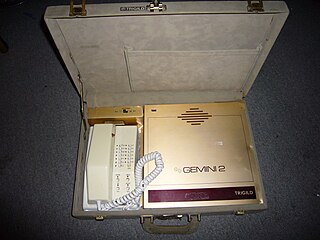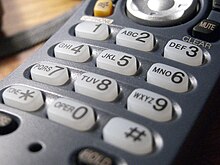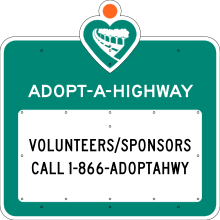
Dual-tone multi-frequency signaling (DTMF) is a telecommunication signaling system using the voice-frequency band over telephone lines between telephone equipment and other communications devices and switching centers. DTMF was first developed in the Bell System in the United States, and became known under the trademark Touch-Tone for use in push-button telephones supplied to telephone customers, starting in 1963. DTMF is standardized as ITU-T Recommendation Q.23. It is also known in the UK as MF4.

A rotary dial /ROUteri daial/ is a component of a telephone or a telephone switchboard that implements a signaling technology in telecommunications known as pulse dialing. It is used when initiating a telephone call to transmit the destination telephone number to a telephone exchange.

Pulse dialing is a signaling technology in telecommunications in which a direct current local loop circuit is interrupted according to a defined coding system for each signal transmitted, usually a digit. This lends the method the often used name loop disconnect dialing. In the most common variant of pulse dialing, decadic dialing, each of the ten Arabic numerals are encoded in a sequence of up to ten pulses. The most common version decodes the digits 1 through 9, as one to nine pulses, respectively, and the digit 0 as ten pulses. Historically, the most common device to produce such pulse trains is the rotary dial of the telephone, lending the technology another name, rotary dialing.
Phreaking is a slang term coined to describe the activity of a culture of people who study, experiment with, or explore telecommunication systems, such as equipment and systems connected to public telephone networks. The term phreak is a sensational spelling of the word freak with the ph- from phone, and may also refer to the use of various audio frequencies to manipulate a phone system. Phreak, phreaker, or phone phreak are names used for and by individuals who participate in phreaking.
Signalling System No. 7 (SS7) is a set of telephony signaling protocols developed in the 1970s, which is used to set up and tear down telephone calls in most parts of the world-wide public switched telephone network (PSTN). The protocol also performs number translation, local number portability, prepaid billing, Short Message Service (SMS), and other services.
A dial tone is a telephony signal sent by a telephone exchange or private branch exchange (PBX) to a terminating device, such as a telephone, when an off-hook condition is detected. It indicates that the exchange is working and is ready to initiate a telephone call. The tone stops when the first dialed digit is recognized. If no digits are forthcoming, the partial dial procedure is invoked, often eliciting a special information tone and an intercept message, followed by the off-hook tone, requiring the caller to hang up and redial.

A blue box is an electronic device that produces tones used to generate the in-band signaling tones formerly used within the North American long-distance telephone network to send line status and called number information over voice circuits. This allowed an illicit user, referred to as a "phreaker", to place long-distance calls, without using the network's user facilities, that would be billed to another number or dismissed entirely as an incomplete call. A number of similar "color boxes" were also created to control other aspects of the phone network.

A telephone call or telephone conversation, also known as a phone call or voice call, is a connection over a telephone network between the called party and the calling party. Telephone calls started in the late 19th century. As technology has improved, a majority of telephone calls are made over a cellular network through mobile phones or over the internet with Voice over IP. Telephone calls are typically used for real-time conversation between two or more parties, especially when the parties cannot meet in person.
In telephony, multi-frequency signaling (MF) is a type of signaling that was introduced by the Bell System after World War II. It uses a combination of audible tones for address transport and supervision signaling on trunk lines between central offices. The signaling is sent in-band over the same channel as the bearer channel used for voice traffic.
In telecommunications, in-band signaling is the sending of control information within the same band or channel used for data such as voice or video. This is in contrast to out-of-band signaling which is sent over a different channel, or even over a separate network. In-band signals may often be heard by telephony participants, while out-of-band signals are inaccessible to the user. The term is also used more generally, for example of computer data files that include both literal data, and metadata and/or instructions for how to process the literal data.
E.123 is an international standard by the standardization union (ITU-T), entitled Notation for national and international telephone numbers, e-mail addresses and web addresses. It provides guidelines for the presentation of telephone numbers, email addresses, and web addresses in print, on letterheads, and similar purposes.

The Improved Mobile Telephone Service (IMTS) was a pre-cellular VHF/UHF radio system which linked to the public telephone network. IMTS was the radiotelephone equivalent of land dial phone service. Introduced in 1964, it replaced Mobile Telephone Service (MTS) and improved on most MTS systems by offering direct-dial rather than connections through a live operator, and full-duplex operation so both parties could talk at the same time.

The Western Electric model 500 telephone series was the standard domestic desk telephone set issued by the Bell System in North America from 1950 through the 1984 Bell System divestiture. Millions of model 500-series phones were produced and were present in most homes in North America. Many are still in use today because of their durability and ample availability. Its modular construction compared to previous types simplified manufacture and repair, and facilitated a large number of variants with added features.
In telephony, call progress tones are audible tones that provide an indication of the status of a telephone call to the user. The tones are generated by a central office or a private branch exchange (PBX) to the calling party.

A keypad is a block or pad of buttons set with an arrangement of digits, symbols, or alphabetical letters. Pads mostly containing numbers and used with computers are numeric keypads. Keypads are found on devices which require mainly numeric input such as calculators, television remotes, push-button telephones, vending machines, ATMs, point of sale terminals, combination locks, safes, and digital door locks. Many devices follow the E.161 standard for their arrangement.

E.161 is an ITU-T Recommendation that defines the arrangement of digits, letters, and symbols on telephone keypads and rotary dials. It also defines the recommended mapping between the basic Latin alphabet and digits. Uses for this mapping include:

A telephone number is a sequence of digits assigned to a landline telephone subscriber station connected to a telephone line or to a wireless electronic telephony device, such as a radio telephone or a mobile telephone, or to other devices for data transmission via the public switched telephone network (PSTN) or other public and private networks.

The push-button telephone is a telephone that has buttons or keys for dialing a telephone number, in contrast to having a rotary dial as in earlier telephone instruments.

A telephone exchange, also known as a telephone switch or central office, is a crucial component in the public switched telephone network (PSTN) or large enterprise telecommunications systems. It facilitates the interconnection of telephone subscriber lines or digital system virtual circuits, enabling telephone calls between subscribers.
Dialling is the action of initiating a telephone call by operating the rotary dial or the telephone keypad of a telephone.
















